Cloud as Data Storage Platform: Retail Industry Perspective
VerifiedAdded on 2021/04/17
|7
|1219
|459
Report
AI Summary
This report examines the advantages of utilizing cloud platforms for data storage, particularly within the retail industry. It highlights the obsolescence of legacy data storage systems due to their cost inefficiencies, lack of understanding, and security vulnerabilities. The report emphasizes the benefits of cloud solutions, including improved data accessibility, efficient data consolidation, and reduced data management costs. It discusses the importance of easy and fast data access for leveraging big data analytics to meet consumer expectations. Furthermore, it addresses critical aspects such as data ownership in the cloud and the significance of understanding contract details with cloud providers. The report concludes by emphasizing the cost-effectiveness of cloud technology compared to in-house setups, enabling businesses to save on capital investments and operational expenses. The study references several academic sources to support its findings, offering a comprehensive overview of cloud data storage's role in modern business.
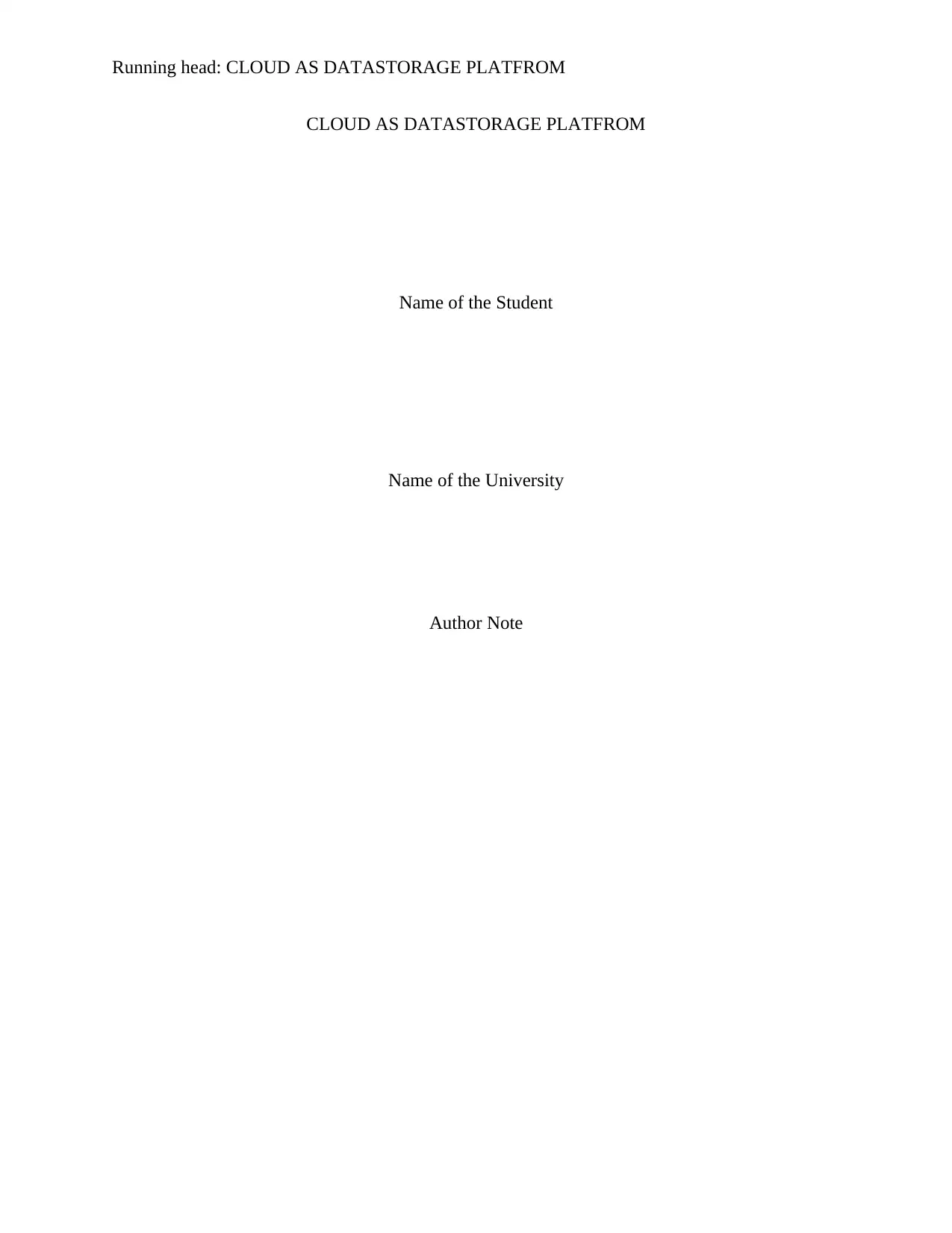
Running head: CLOUD AS DATASTORAGE PLATFROM
CLOUD AS DATASTORAGE PLATFROM
Name of the Student
Name of the University
Author Note
CLOUD AS DATASTORAGE PLATFROM
Name of the Student
Name of the University
Author Note
Paraphrase This Document
Need a fresh take? Get an instant paraphrase of this document with our AI Paraphraser
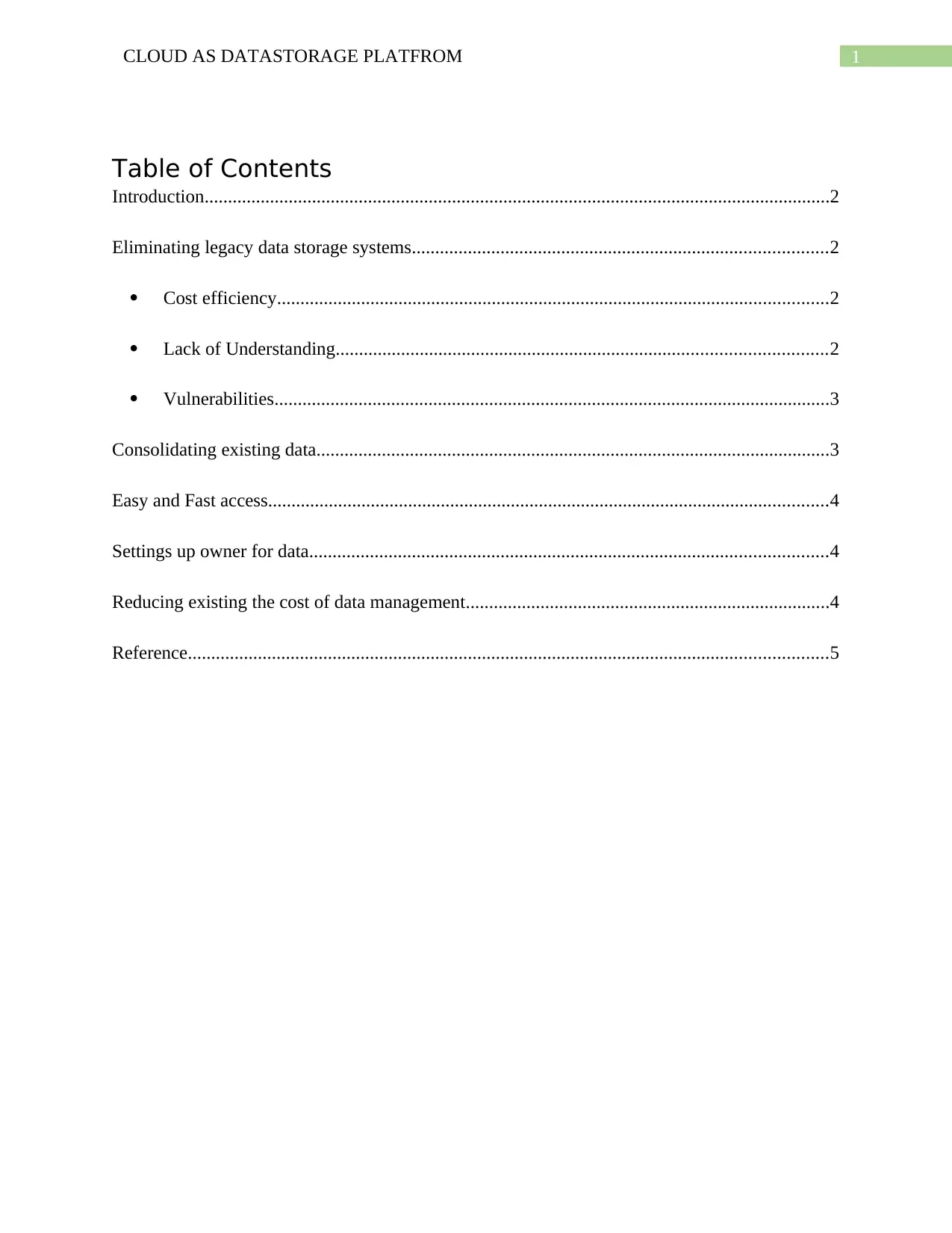
1CLOUD AS DATASTORAGE PLATFROM
Table of Contents
Introduction......................................................................................................................................2
Eliminating legacy data storage systems.........................................................................................2
Cost efficiency......................................................................................................................2
Lack of Understanding.........................................................................................................2
Vulnerabilities.......................................................................................................................3
Consolidating existing data..............................................................................................................3
Easy and Fast access........................................................................................................................4
Settings up owner for data...............................................................................................................4
Reducing existing the cost of data management..............................................................................4
Reference.........................................................................................................................................5
Table of Contents
Introduction......................................................................................................................................2
Eliminating legacy data storage systems.........................................................................................2
Cost efficiency......................................................................................................................2
Lack of Understanding.........................................................................................................2
Vulnerabilities.......................................................................................................................3
Consolidating existing data..............................................................................................................3
Easy and Fast access........................................................................................................................4
Settings up owner for data...............................................................................................................4
Reducing existing the cost of data management..............................................................................4
Reference.........................................................................................................................................5
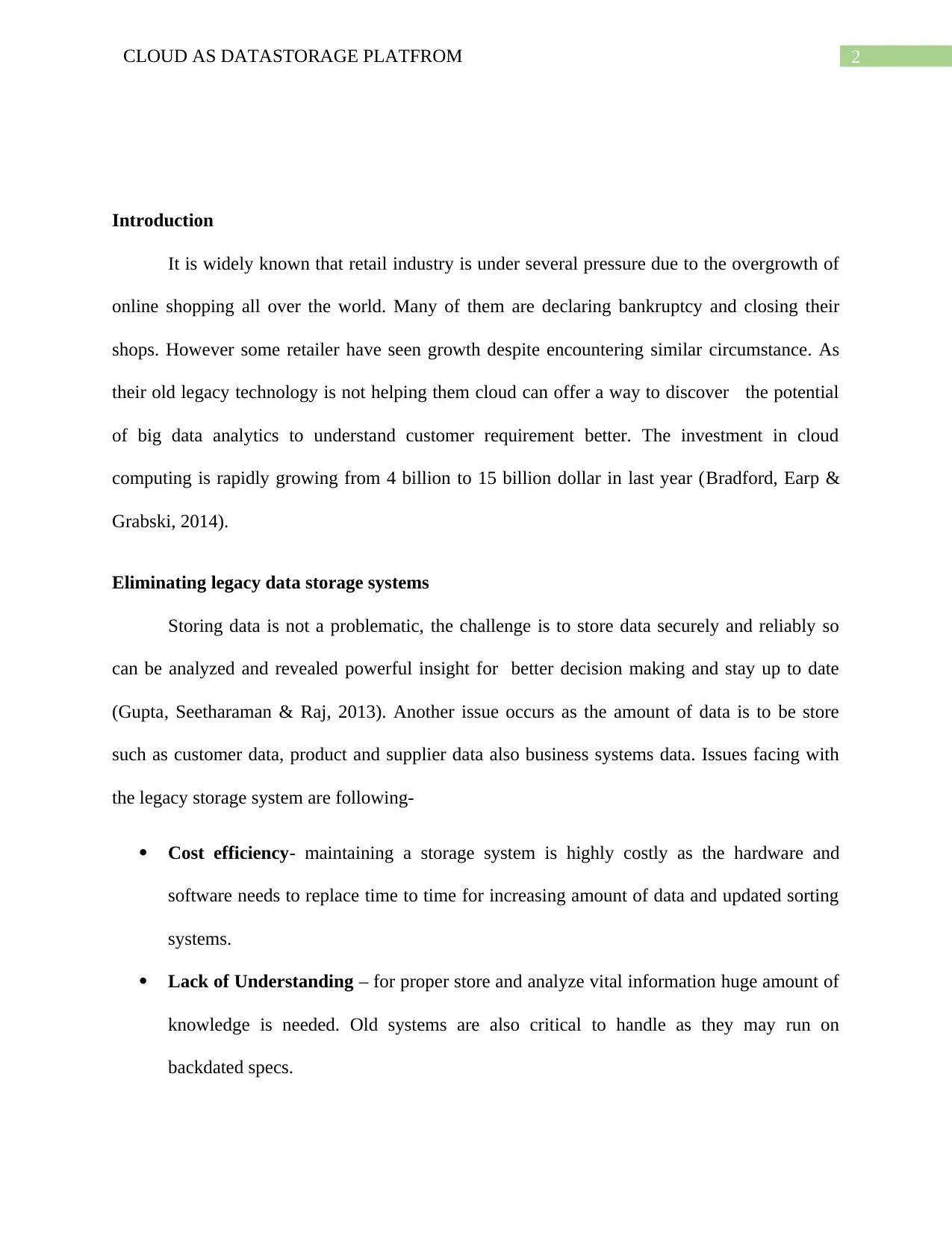
2CLOUD AS DATASTORAGE PLATFROM
Introduction
It is widely known that retail industry is under several pressure due to the overgrowth of
online shopping all over the world. Many of them are declaring bankruptcy and closing their
shops. However some retailer have seen growth despite encountering similar circumstance. As
their old legacy technology is not helping them cloud can offer a way to discover the potential
of big data analytics to understand customer requirement better. The investment in cloud
computing is rapidly growing from 4 billion to 15 billion dollar in last year (Bradford, Earp &
Grabski, 2014).
Eliminating legacy data storage systems
Storing data is not a problematic, the challenge is to store data securely and reliably so
can be analyzed and revealed powerful insight for better decision making and stay up to date
(Gupta, Seetharaman & Raj, 2013). Another issue occurs as the amount of data is to be store
such as customer data, product and supplier data also business systems data. Issues facing with
the legacy storage system are following-
Cost efficiency- maintaining a storage system is highly costly as the hardware and
software needs to replace time to time for increasing amount of data and updated sorting
systems.
Lack of Understanding – for proper store and analyze vital information huge amount of
knowledge is needed. Old systems are also critical to handle as they may run on
backdated specs.
Introduction
It is widely known that retail industry is under several pressure due to the overgrowth of
online shopping all over the world. Many of them are declaring bankruptcy and closing their
shops. However some retailer have seen growth despite encountering similar circumstance. As
their old legacy technology is not helping them cloud can offer a way to discover the potential
of big data analytics to understand customer requirement better. The investment in cloud
computing is rapidly growing from 4 billion to 15 billion dollar in last year (Bradford, Earp &
Grabski, 2014).
Eliminating legacy data storage systems
Storing data is not a problematic, the challenge is to store data securely and reliably so
can be analyzed and revealed powerful insight for better decision making and stay up to date
(Gupta, Seetharaman & Raj, 2013). Another issue occurs as the amount of data is to be store
such as customer data, product and supplier data also business systems data. Issues facing with
the legacy storage system are following-
Cost efficiency- maintaining a storage system is highly costly as the hardware and
software needs to replace time to time for increasing amount of data and updated sorting
systems.
Lack of Understanding – for proper store and analyze vital information huge amount of
knowledge is needed. Old systems are also critical to handle as they may run on
backdated specs.
⊘ This is a preview!⊘
Do you want full access?
Subscribe today to unlock all pages.

Trusted by 1+ million students worldwide
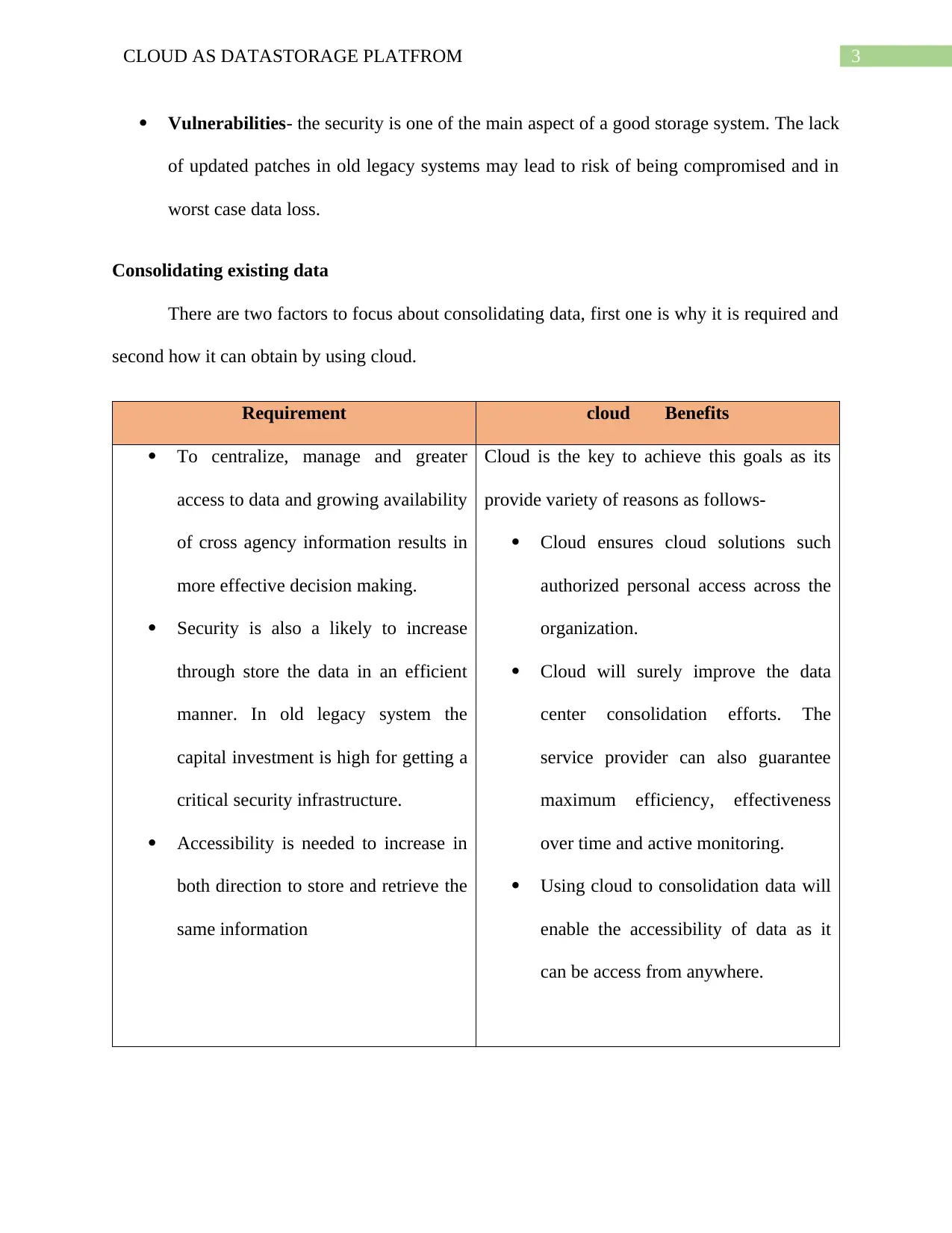
3CLOUD AS DATASTORAGE PLATFROM
Vulnerabilities- the security is one of the main aspect of a good storage system. The lack
of updated patches in old legacy systems may lead to risk of being compromised and in
worst case data loss.
Consolidating existing data
There are two factors to focus about consolidating data, first one is why it is required and
second how it can obtain by using cloud.
Requirement cloud Benefits
To centralize, manage and greater
access to data and growing availability
of cross agency information results in
more effective decision making.
Security is also a likely to increase
through store the data in an efficient
manner. In old legacy system the
capital investment is high for getting a
critical security infrastructure.
Accessibility is needed to increase in
both direction to store and retrieve the
same information
Cloud is the key to achieve this goals as its
provide variety of reasons as follows-
Cloud ensures cloud solutions such
authorized personal access across the
organization.
Cloud will surely improve the data
center consolidation efforts. The
service provider can also guarantee
maximum efficiency, effectiveness
over time and active monitoring.
Using cloud to consolidation data will
enable the accessibility of data as it
can be access from anywhere.
Vulnerabilities- the security is one of the main aspect of a good storage system. The lack
of updated patches in old legacy systems may lead to risk of being compromised and in
worst case data loss.
Consolidating existing data
There are two factors to focus about consolidating data, first one is why it is required and
second how it can obtain by using cloud.
Requirement cloud Benefits
To centralize, manage and greater
access to data and growing availability
of cross agency information results in
more effective decision making.
Security is also a likely to increase
through store the data in an efficient
manner. In old legacy system the
capital investment is high for getting a
critical security infrastructure.
Accessibility is needed to increase in
both direction to store and retrieve the
same information
Cloud is the key to achieve this goals as its
provide variety of reasons as follows-
Cloud ensures cloud solutions such
authorized personal access across the
organization.
Cloud will surely improve the data
center consolidation efforts. The
service provider can also guarantee
maximum efficiency, effectiveness
over time and active monitoring.
Using cloud to consolidation data will
enable the accessibility of data as it
can be access from anywhere.
Paraphrase This Document
Need a fresh take? Get an instant paraphrase of this document with our AI Paraphraser
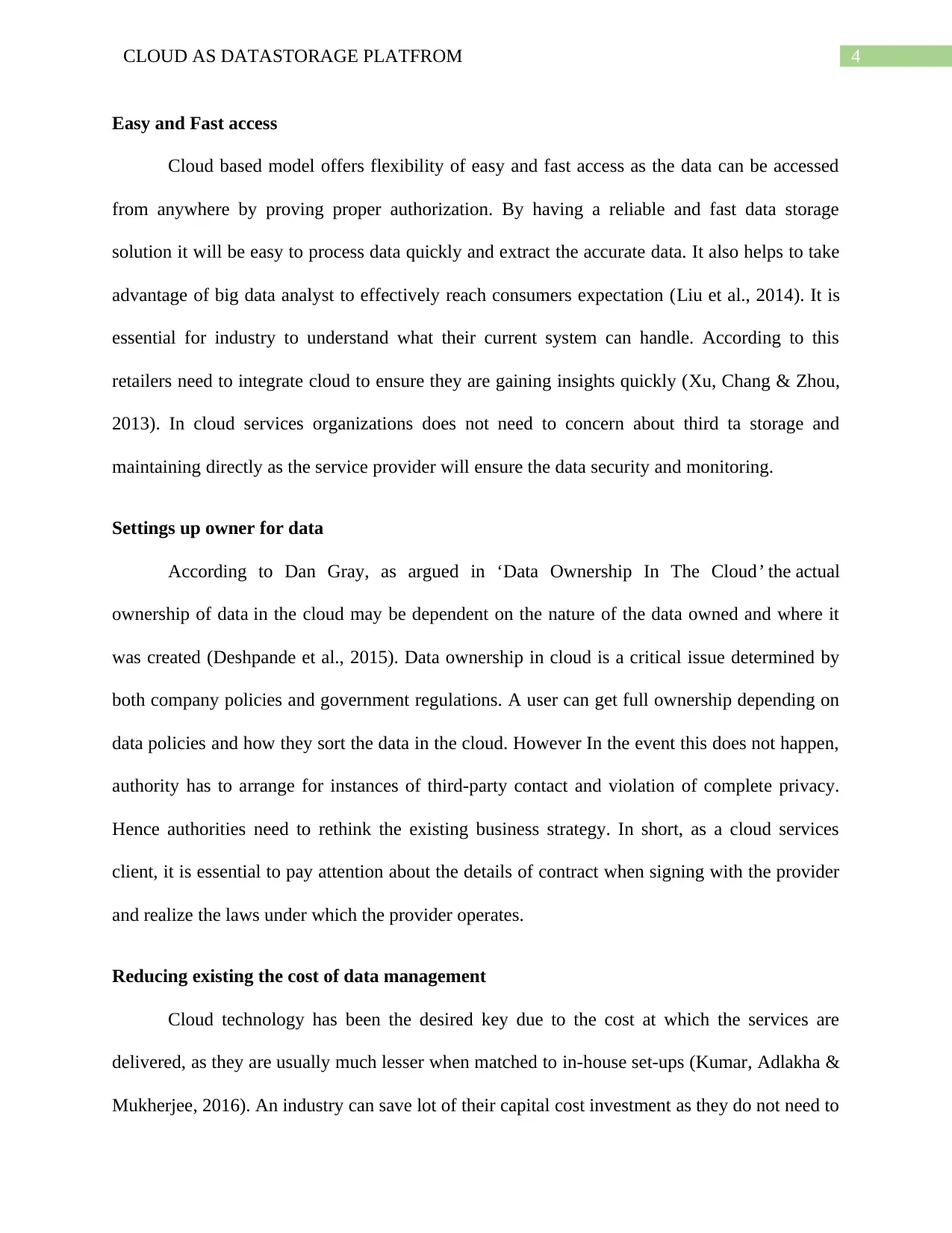
4CLOUD AS DATASTORAGE PLATFROM
Easy and Fast access
Cloud based model offers flexibility of easy and fast access as the data can be accessed
from anywhere by proving proper authorization. By having a reliable and fast data storage
solution it will be easy to process data quickly and extract the accurate data. It also helps to take
advantage of big data analyst to effectively reach consumers expectation (Liu et al., 2014). It is
essential for industry to understand what their current system can handle. According to this
retailers need to integrate cloud to ensure they are gaining insights quickly (Xu, Chang & Zhou,
2013). In cloud services organizations does not need to concern about third ta storage and
maintaining directly as the service provider will ensure the data security and monitoring.
Settings up owner for data
According to Dan Gray, as argued in ‘Data Ownership In The Cloud’ the actual
ownership of data in the cloud may be dependent on the nature of the data owned and where it
was created (Deshpande et al., 2015). Data ownership in cloud is a critical issue determined by
both company policies and government regulations. A user can get full ownership depending on
data policies and how they sort the data in the cloud. However In the event this does not happen,
authority has to arrange for instances of third-party contact and violation of complete privacy.
Hence authorities need to rethink the existing business strategy. In short, as a cloud services
client, it is essential to pay attention about the details of contract when signing with the provider
and realize the laws under which the provider operates.
Reducing existing the cost of data management
Cloud technology has been the desired key due to the cost at which the services are
delivered, as they are usually much lesser when matched to in-house set-ups (Kumar, Adlakha &
Mukherjee, 2016). An industry can save lot of their capital cost investment as they do not need to
Easy and Fast access
Cloud based model offers flexibility of easy and fast access as the data can be accessed
from anywhere by proving proper authorization. By having a reliable and fast data storage
solution it will be easy to process data quickly and extract the accurate data. It also helps to take
advantage of big data analyst to effectively reach consumers expectation (Liu et al., 2014). It is
essential for industry to understand what their current system can handle. According to this
retailers need to integrate cloud to ensure they are gaining insights quickly (Xu, Chang & Zhou,
2013). In cloud services organizations does not need to concern about third ta storage and
maintaining directly as the service provider will ensure the data security and monitoring.
Settings up owner for data
According to Dan Gray, as argued in ‘Data Ownership In The Cloud’ the actual
ownership of data in the cloud may be dependent on the nature of the data owned and where it
was created (Deshpande et al., 2015). Data ownership in cloud is a critical issue determined by
both company policies and government regulations. A user can get full ownership depending on
data policies and how they sort the data in the cloud. However In the event this does not happen,
authority has to arrange for instances of third-party contact and violation of complete privacy.
Hence authorities need to rethink the existing business strategy. In short, as a cloud services
client, it is essential to pay attention about the details of contract when signing with the provider
and realize the laws under which the provider operates.
Reducing existing the cost of data management
Cloud technology has been the desired key due to the cost at which the services are
delivered, as they are usually much lesser when matched to in-house set-ups (Kumar, Adlakha &
Mukherjee, 2016). An industry can save lot of their capital cost investment as they do not need to
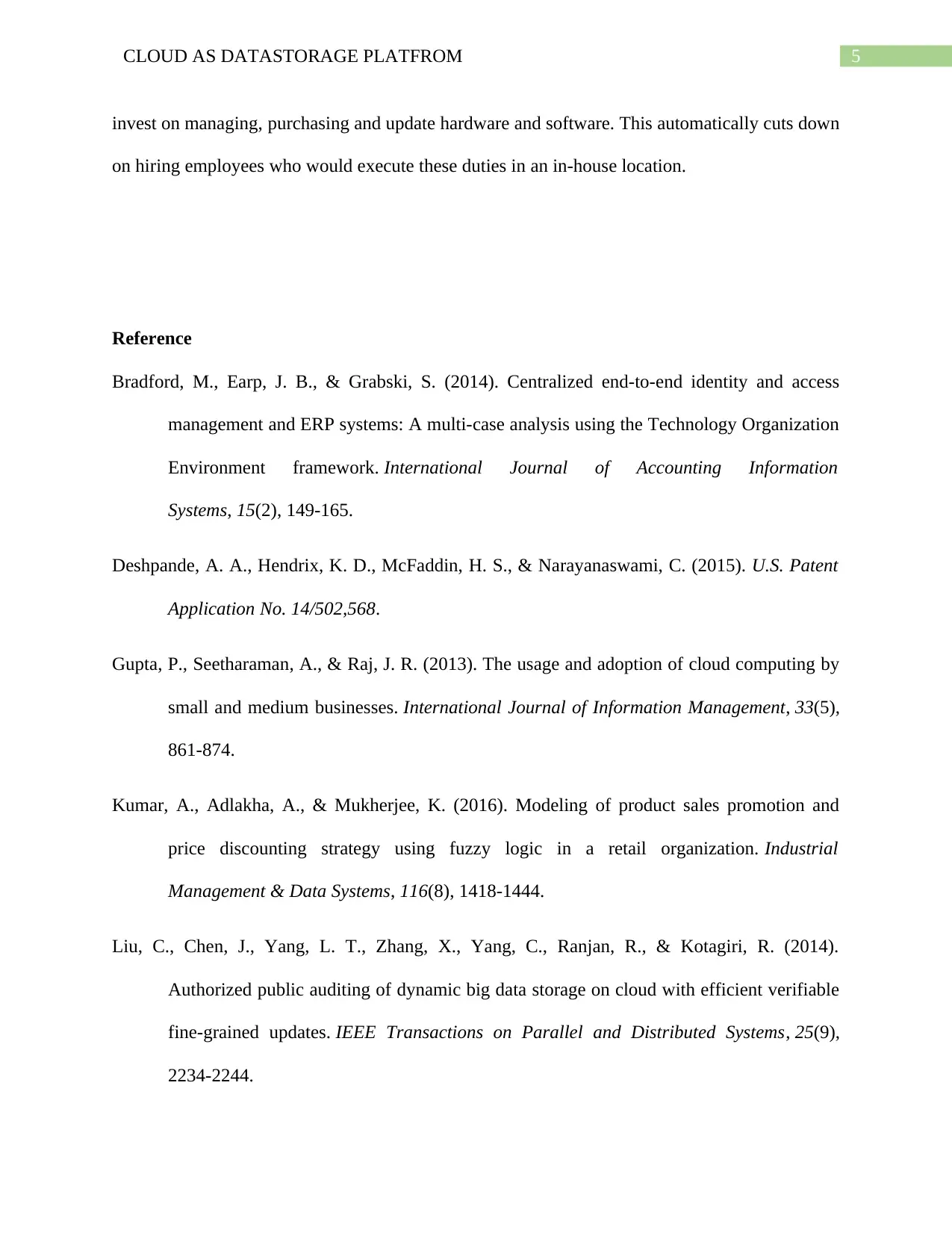
5CLOUD AS DATASTORAGE PLATFROM
invest on managing, purchasing and update hardware and software. This automatically cuts down
on hiring employees who would execute these duties in an in-house location.
Reference
Bradford, M., Earp, J. B., & Grabski, S. (2014). Centralized end-to-end identity and access
management and ERP systems: A multi-case analysis using the Technology Organization
Environment framework. International Journal of Accounting Information
Systems, 15(2), 149-165.
Deshpande, A. A., Hendrix, K. D., McFaddin, H. S., & Narayanaswami, C. (2015). U.S. Patent
Application No. 14/502,568.
Gupta, P., Seetharaman, A., & Raj, J. R. (2013). The usage and adoption of cloud computing by
small and medium businesses. International Journal of Information Management, 33(5),
861-874.
Kumar, A., Adlakha, A., & Mukherjee, K. (2016). Modeling of product sales promotion and
price discounting strategy using fuzzy logic in a retail organization. Industrial
Management & Data Systems, 116(8), 1418-1444.
Liu, C., Chen, J., Yang, L. T., Zhang, X., Yang, C., Ranjan, R., & Kotagiri, R. (2014).
Authorized public auditing of dynamic big data storage on cloud with efficient verifiable
fine-grained updates. IEEE Transactions on Parallel and Distributed Systems, 25(9),
2234-2244.
invest on managing, purchasing and update hardware and software. This automatically cuts down
on hiring employees who would execute these duties in an in-house location.
Reference
Bradford, M., Earp, J. B., & Grabski, S. (2014). Centralized end-to-end identity and access
management and ERP systems: A multi-case analysis using the Technology Organization
Environment framework. International Journal of Accounting Information
Systems, 15(2), 149-165.
Deshpande, A. A., Hendrix, K. D., McFaddin, H. S., & Narayanaswami, C. (2015). U.S. Patent
Application No. 14/502,568.
Gupta, P., Seetharaman, A., & Raj, J. R. (2013). The usage and adoption of cloud computing by
small and medium businesses. International Journal of Information Management, 33(5),
861-874.
Kumar, A., Adlakha, A., & Mukherjee, K. (2016). Modeling of product sales promotion and
price discounting strategy using fuzzy logic in a retail organization. Industrial
Management & Data Systems, 116(8), 1418-1444.
Liu, C., Chen, J., Yang, L. T., Zhang, X., Yang, C., Ranjan, R., & Kotagiri, R. (2014).
Authorized public auditing of dynamic big data storage on cloud with efficient verifiable
fine-grained updates. IEEE Transactions on Parallel and Distributed Systems, 25(9),
2234-2244.
⊘ This is a preview!⊘
Do you want full access?
Subscribe today to unlock all pages.

Trusted by 1+ million students worldwide

6CLOUD AS DATASTORAGE PLATFROM
Xu, J., Chang, E. C., & Zhou, J. (2013, May). Weak leakage-resilient client-side deduplication of
encrypted data in cloud storage. In Proceedings of the 8th ACM SIGSAC symposium on
Information, computer and communications security (pp. 195-206). ACM.
Xu, J., Chang, E. C., & Zhou, J. (2013, May). Weak leakage-resilient client-side deduplication of
encrypted data in cloud storage. In Proceedings of the 8th ACM SIGSAC symposium on
Information, computer and communications security (pp. 195-206). ACM.
1 out of 7
Related Documents
Your All-in-One AI-Powered Toolkit for Academic Success.
+13062052269
info@desklib.com
Available 24*7 on WhatsApp / Email
![[object Object]](/_next/static/media/star-bottom.7253800d.svg)
Unlock your academic potential
Copyright © 2020–2025 A2Z Services. All Rights Reserved. Developed and managed by ZUCOL.





